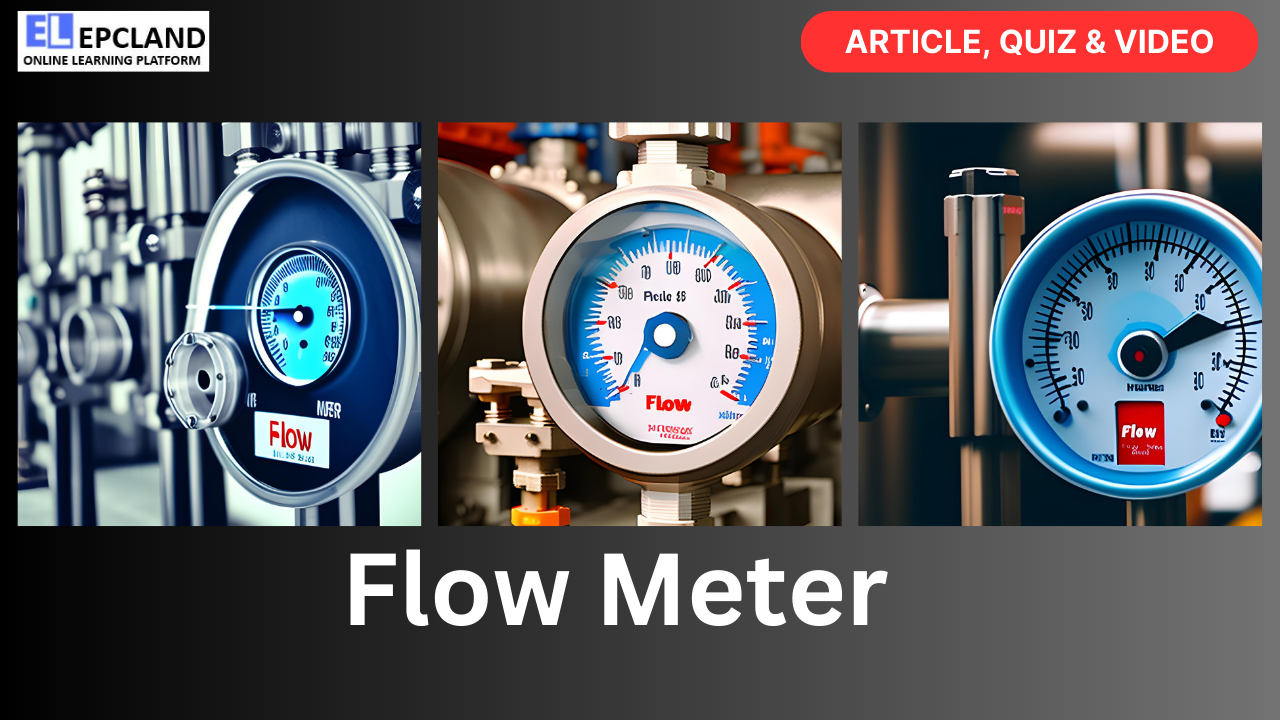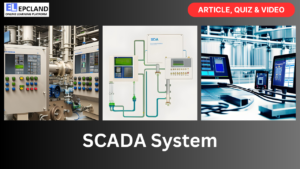Flow meters are a cornerstone of the Oil & Gas Industry, playing a pivotal role in measuring the flow rates of hydrocarbons and other fluids. Accurate flow measurement is essential for monitoring and optimizing production, ensuring safety, and complying with regulatory requirements. In this article, we will explore the world of flow meters in the context of oil and gas projects, delving into their types, working principles, applications, advantages, disadvantages, calibration, challenges, and the role they play in the industry’s success.
Table of Contents
Do not miss the Complete Course on Piping Engineering
By EPCLand
Introduction to Flow Meters in the Oil & Gas Industry
Flow meters are instruments designed to measure the rate of flow (quantity per unit of time) of a fluid, whether it’s a liquid, gas, or a mixture of both. In the Oil & Gas Industry, flow meters are instrumental for several critical functions:
1. Custody Transfer
When hydrocarbons are transferred between companies or entities, accurate flow measurement is crucial to determine the volume and value of the product being exchanged. Custody transfer flow meters are used to ensure fair transactions.
2. Process Control
Flow meters help maintain and control the flow of fluids within the production and refining processes. They provide real-time data to optimize the operation of equipment and maintain consistent product quality.
3. Safety
Accurate flow measurement is vital for safety reasons. It helps detect leaks, monitor pipeline integrity, and prevent over-pressurization, reducing the risk of accidents and environmental damage.
4. Regulatory Compliance
Many countries and regions have strict regulations governing the measurement and reporting of hydrocarbon flows. Flow meters play a crucial role in ensuring compliance with these regulations.
Types of Flow Meters Used in Oil & Gas Projects
Flow meters come in various types, each suited to specific applications and operating conditions. The choice of flow meter depends on factors such as fluid type, flow rate, pressure, and temperature. Here are some common types used in the Oil & Gas Industry:
1. Differential Pressure (DP) Flow Meters
Working Principle: These meters work on the principle of creating a pressure drop across an obstruction in the flow path. The pressure difference is proportional to the flow rate. Orifice plates, venturi tubes, and flow nozzles are examples of DP flow meters.
2. Turbine Flow Meters
Working Principle: Turbine flow meters employ a rotating turbine placed in the fluid stream. The rate of rotation is directly proportional to the flow rate. They are suitable for measuring clean, low-viscosity liquids and gases.
3. Coriolis Flow Meters
Working Principle: Coriolis flow meters use the Coriolis effect, which causes a vibrating tube to twist proportionally to the mass flow rate. They are highly accurate and can handle a wide range of fluid properties.
4. Magnetic Flow Meters
Working Principle: Magnetic flow meters, or magmeters, measure flow by applying a magnetic field to the conductive fluid and measuring the voltage generated as the fluid flows through a pipe. They are ideal for measuring the flow of conductive liquids.
5. Ultrasonic Flow Meters
Working Principle: Ultrasonic flow meters use ultrasonic waves to measure the velocity of a fluid. There are two main types: transit-time and Doppler flow meters. They are non-invasive and suitable for a variety of fluid types.
6. Positive Displacement Flow Meters
Working Principle: Positive displacement flow meters trap and measure a fixed volume of fluid and then count the number of times this volume is filled and emptied. They are highly accurate and are often used for measuring viscous fluids.
7. Vortex Flow Meters
Working Principle: Vortex flow meters work by detecting the vortices or swirls created by the fluid as it passes an obstruction. The frequency of vortices is proportional to the flow rate. They are suitable for measuring gas and liquid flow.
Do not miss the Complete Course on Piping Engineering
By EPCLand
Applications of Flow Meters in Oil & Gas Projects
Flow meters find applications at various stages of oil and gas projects, from exploration and production to refining and distribution:
1. Exploration and Drilling
In the initial stages of oil and gas projects, flow meters are used to monitor the flow of drilling mud, which is critical for wellbore stability and controlling formation pressure. They also measure the flow of fluids during well testing to assess reservoir potential.
2. Production and Well Testing
During production, flow meters measure the flow of hydrocarbons from wells. This data helps operators optimize production rates, detect equipment issues, and ensure safe and efficient operations. Well testing flow meters are critical for evaluating reservoir performance.
3. Refining and Processing
In refineries and processing plants, flow meters play a central role in monitoring and controlling the movement of fluids throughout the facility. They are used in processes such as distillation, blending, and chemical reactions to ensure accurate proportions and maintain product quality.
4. Pipeline Transportation
Pipeline flow meters are essential for monitoring the flow of hydrocarbons through pipelines that can span hundreds or thousands of kilometers. Accurate measurement is crucial for tracking product volumes, detecting leaks, and ensuring safe and efficient transportation.
5. Custody Transfer
Custody transfer flow meters are used when ownership of hydrocarbons changes hands. These meters ensure that both parties agree on the quantity and quality of the product being transferred, reducing disputes and losses.
Advantages and Disadvantages of Flow Meters
Flow meters offer several advantages and disadvantages depending on their type and application. Below is a table summarizing these factors:
| Flow Meter Type | Advantages | Disadvantages |
|---|---|---|
| Differential Pressure (DP) | – Simple and robust design | – Pressure drop across the meter |
| – Suitable for a wide range of fluids | – Requires frequent calibration | |
| Turbine | – High accuracy | – Susceptible to wear and erosion |
| – Suitable for clean, low-viscosity fluids | – Limited to specific fluid types | |
| Coriolis | – Exceptional accuracy | – High initial cost |
| – Handles a wide range of fluid properties | – Susceptible to clogging and fouling | |
| Magnetic | – Excellent for conductive liquids | – Limited to conductive fluids |
| Flow Meters | – Minimal pressure drop | – Not suitable for non-conductive fluids |
| Ultrasonic | – Non-invasive measurement | – Performance affected by gas bubbles |
| – Suitable for various fluid types | – Initial cost can be high | |
| Positive Displacement | – Highly accurate | – Limited to low to medium flow rates |
| – Suitable for viscous fluids | – Susceptible to wear and maintenance issues | |
| Vortex | – Low maintenance requirements | – Sensitive to changes in flow conditions |
| – Suitable for gas and liquid flow | – Lower accuracy compared to some other types |
Do not miss the Complete Course on Piping Engineering
By EPCLand
Calibration of Flow Meters in Oil & Gas Projects
Calibration is a critical aspect of flow meter performance in the Oil & Gas Industry. Regular calibration ensures that flow meters provide accurate and reliable measurements. Calibration involves comparing the output of the flow meter to a known standard over a range of flow rates and conditions. The calibration process considers factors such as fluid properties, temperature, and pressure.
Flow meter calibration is typically performed in specialized facilities using master meters or standards traceable to national or international metrology organizations. In some cases, on-site calibration may be necessary, especially for critical custody transfer meters.
Challenges and Considerations in Flow Metering
Despite their importance, flow metering in the Oil & Gas Industry presents several challenges and considerations:
1. Fluid Properties
The properties of the fluid being measured, such as viscosity, density, and temperature, can affect flow meter accuracy. Flow meters must be selected to account for these variations.
2. Maintenance
Flow meters require regular maintenance to ensure accurate measurements. This includes cleaning, calibration, and inspection of components.
3. Extreme Conditions
Oil and gas projects often operate in harsh environments with extreme temperatures and pressures. Flow meters must be robust and capable of withstanding these conditions.
4. Turbulence and Flow Profiles
Turbulent flow and non-uniform flow profiles can affect the accuracy of some flow meters. Proper installation and upstream/downstream piping configurations are essential to mitigate these effects.
5. Selection and Sizing
Selecting the right type and size of flow meter for a specific application is crucial. Incorrect sizing can lead to inaccuracies and inefficiencies.
Conclusion
Flow meters are the unsung heroes of the Oil & Gas Industry, providing the essential data needed to monitor, control, and optimize operations. From the wellhead to the refinery to the distribution network, accurate flow measurement is fundamental for efficient and safe processes. The diverse types of flow meters available cater to a wide range of applications, while regular calibration ensures their reliability.
As the industry continues to evolve, the demand for precise flow measurement will only increase. Flow meters will play a crucial role in addressing environmental concerns, improving efficiency, and complying with evolving regulations. Whether measuring the flow of crude oil through a pipeline or the precise blending of chemicals in a refinery, flow meters are the silent sentinels ensuring that the Oil & Gas Industry continues to fuel the world’s energy needs reliably and responsibly.
FAQs
- What is the primary role of flow meters in the Oil & Gas Industry?Flow meters are essential for measuring the flow rates of hydrocarbons and other fluids at various stages of oil and gas projects. Their primary roles include custody transfer, process control, safety monitoring, and ensuring compliance with regulatory requirements.
- How do Coriolis flow meters work, and what makes them suitable for the Oil & Gas Industry?Coriolis flow meters operate on the principle of the Coriolis effect, where a vibrating tube twists in proportion to the mass flow rate of the fluid. This twisting is measured to determine flow. They are suitable for the industry due to their exceptional accuracy and capability to handle a wide range of fluid properties.
- What are the advantages of using ultrasonic flow meters in oil and gas applications?Ultrasonic flow meters offer non-invasive measurement, making them suitable for various fluid types without disrupting the flow. They are also known for their accuracy and are less affected by factors like fluid composition or viscosity.
- Why is calibration crucial for flow meters in the Oil & Gas Industry?Calibration is essential to ensure that flow meters provide accurate and reliable measurements. It involves comparing a flow meter’s output to a known standard. Regular calibration helps maintain measurement accuracy, which is critical for custody transfer, safety, and regulatory compliance.
- What are the main challenges faced when using flow meters in extreme conditions within the industry?Flow meters in the Oil & Gas Industry often operate in harsh environments with extreme temperatures and pressures. Challenges include ensuring flow meter robustness, mitigating the effects of turbulent flow and non-uniform flow profiles, and selecting appropriate meters that can withstand these conditions without compromising accuracy.
Do not miss the Complete Course on Piping Engineering
By EPCLand
Recommended courses (Published on EPCLand)
- Basics of Piping Engineering
- Piping Layout Engineering
- Piping Material Engineering
- Piping Stress Analysis
- Complete Course on Piping Engineering
- Material Requisitions
- Piping Material Specifications
- Valve Material Specifications
Don’t miss the published articles on following:
| Industrial Applications with Link | Industrial Applications with Link |
| Corrosion Monitoring Instruments | Safety Instrumented Systems |
| Instrumentation in Renewable Energy | Safety Relief Valves |
| Orifice Plate in the Oil & Gas Industry | Well Test Instruments |
| Wellhead Pressure and Temperature Gauges | Wireless Instrumentation in Oil & Gas Projects |
Related Video
Attempt Quiz
Question 1:
What is the primary purpose of a flow meter in an oil & gas project?
Explanation: The primary purpose of a flow meter in an oil & gas project is to measure the flow rate of fluids, such as oil, gas, or water, within the system.
Question 2:
Which type of flow meter relies on the Coriolis effect to measure flow?
Explanation: A Coriolis flow meter relies on the Coriolis effect to measure flow by analyzing the changes in the fluid’s momentum as it flows through a vibrating tube.
Question 3:
What is the advantage of using a magnetic flow meter in corrosive fluid applications?
Explanation: The advantage of using a magnetic flow meter in corrosive fluid applications is its resistance to corrosion, making it suitable for measuring flow in challenging environments.
Question 4:
What is the primary measurement unit used in gas flow meters?
Explanation: Gas flow meters primarily use the measurement unit of cubic meters (m³) for quantifying gas flow rates.
Question 5:
Which flow meter type is suitable for measuring the flow of steam in steam-based processes?
Explanation: Turbine flow meters are often used to measure the flow of steam in steam-based processes due to their suitability for high-temperature applications.



